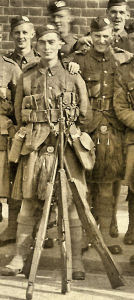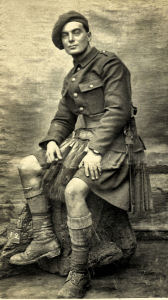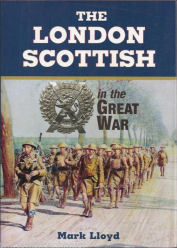|
The London Scottish Regiment |
|
|||||||
|
The London Scottish Regiment |
|
|||||||
The 14th County of London Regiment (the London Scottish) was a territorial regiment that went to Abbots Langley to train in August 1914 and were sent on to France in September. They were the first regiment of the 2nd London Division (later the 47th Division) to see action, with fatal consequences for many of the men.
The Second Line Battalion was based in the Watford area between April and June 1915, and attended a musketry course at North Mimms in August 1915. They later went to France, Salonika and Egypt as part of the 60th Division.
|
Men of the London Gunners Regiment in rural billet, in Abbots Langley area during August or September, 1914
Postcard by Harry Cull, Photographer, 169 St Albans Road, Watford
Negative No (in pencil) 1093/10 |
||||
|
|
The London Scottish cap badge |
|||
|
|
Cap Badge from photograph
|
|||
|
|
|
Infantry Battalions to the Front.
In September it was decided to send the London Scottish Battalion to reinforce the Expeditionary Force. Lieutenant Colonel Collen recorded their departure:
London Gunners, Chapter 17. |
|
|
The First Battle involving the London Scottish
When the London Scottish Battalion sailed for France Lieutenant Colonel Collen had recorded in his diary his doubts about their battle readiness. For six weeks they carried out duties behind the lines, such as escorting prisoners to the coast, unloading supplies from ships, putting up huts, and such like. On the 31st October, 1915, they had the opportunity to fight on the ridge at Wytschaete, near Ypres. They rushed forward with vigour. “Then someone discovered that the Germans were coming up in a solid mass behind us, so we doubled back to hold the trench. ... The people we had fired on turned on us and started to advance, and a third lot was bearing down to enfilade us. The sergeant’s rifle jammed permanently then. He took mine, but that jammed too! So had most of the rest - and we were almost surrounded. There was a ring of fire round the trench and just one solid sound of bullets.”
The British Press, including The Gazette, praised the courage of the London Scottish while carefully drawing a veil over their casualties and foolhardiness. Inexperienced as they were, and determined to show the Regulars that the Territorial could fight, they had misread the situation, forgot about their flanks, and found themselves under heavy fire from three sides. Of the 750 men who had attacked, 345 were killed, wounded or missing by the following day. London Gunners, Chapter 19. |
(No publisher - description printed on reverse) After being in position but 48 hours the London Scottish were ordered to attack a village. Under darkness they advanced and when within a few hundred yards charged with their bayonets. After a few sharp thrusts in the narrow streets the Germans fled and the London Scottish won their first success. |
 |
 |
|
|
Frank Moffat Pictures kindly provided by his granddaughter Valerie Hatton of Queensland, Australia |
This card shows soldiers of the London Scottish, location unknown, but photographed by Harry Cull of Watford, suggesting they were in the Watford area. There is some ambiguity over the correct negative number, but the soldiers probably come from the First Battalion, who went to France in September 1914, and not the 2nd Battalion, which moved to Watford in April 1915. |
Frank Moffat ?in France?
Another undated picture shows him in Reigate |
Second Line Troops - the 2/14th Battalion (London Scottish)
|
Musketry Camp, North Mimms, August 1915 Images kindly provided by Peter Miller
Photographer: W. H. Christmas, Photographer, 8 Queens Road, Bowes Park, N He was probably Walter Henry Christmas, brother of Lea Latimer Christmas, photographer of Watford and St Albans. In 1911 Walter was described as a clerk living at 8 Queens Road, Wood Green.
Miss L. Piper was undoubtedly Lily Morgan Gordon Piper (born 1887, Baxted, Sussex) who in 1911 was one of a number of servants living in the house of Sir Reginald Hardy, Colonel, Staffordshire Yeomanry, at Dunstall. The identity of Doug is unknown and there are no obvious clues as Lily did not have a brother of that name and her husband, when she married in 1931, was a Russell E Gates. |
||||||||||||||||||
 |
The London Scottish In The Great War Mark Lloyd 2001 1st Ed For two centuries the officers and men of the London Scottish have faithfully served their country and never more so than during the terrible years of the Great War. Initially with the 1st Guards Brigade and later with the 56th (London) Division, the 1st Battalion served in France and Flanders throughout the War. They were the first Territorial soldiers to be committed to battle when, at Messines in 1914, they suffered one-third casualties and were among the last to disengage. So dedicated was the London Scottish to the prosecution of its cause that, by November 1918, the 1st Battalion included only three survivors of the original Battle of Messines. The 2nd Battalion saw action in campaigns as diverse as France and Flanders, Ireland, the Balkans and Palestine where it won two Victoria Crosses. |
|
|
[I have not seen this book but include details for information. |
||
| November 2011 | Page created | |
| December 2012 | Card provided by Valerie | |
| January 2013 | Battle PC added | |
| January 2014 | North Mimms cards | |
| April 2014 |